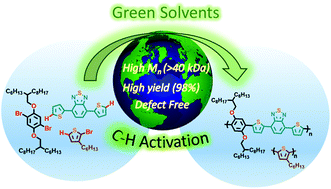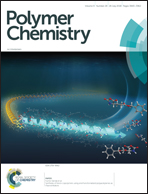Investigation of green and sustainable solvents for direct arylation polymerization (DArP)†
Abstract
Direct arylation polymerization (DArP) is an emerging method for conjugated polymer synthesis. It alleviates typical synthetic routes from toxic, hazardous materials, such as pyrophorphoric organolithium or highly-toxic stannane reagents. The progress and development of synthetic methodologies for DArP have allowed for the preparation of conjugated polymers with a minimization or exclusion of undesired couplings, such as branching (β) defects and donor–donor or acceptor–acceptor homocouplings. This has allowed for conjugated polymers prepared using DArP to converge upon or surpass the performance of polymers prepared using conventional polymerization methods, e.g. Stille or Suzuki, when integrated into polymer bulk-heterojunction solar cells. Considering that DArP has the potential to become the industrial-scale method for conjugated polymer synthesis, determining the compatability of environmentally benign, non-hazardous, and low-cost solvents with DArP is imperative. Herein, we report the application of green and sustainable solvents, such as 2-methyltetrahydrofuran, cyclopentyl methyl ether, diethylcarbonate, and γ-valerolactone, for DArP towards the preparation of poly[(2,5-bis(2-hexyldecyloxy)phenylene)-alt-(4,7-di(thiophen-2-yl)benzo[c][1,2,5]thiadiazole) (PPDTBT) and poly(3-hexylthiophene) (P3HT), where optimal conditions are derived based on the molecular weight, yield, and characterization (NMR, XRD, and UV-vis) for the aforementioned polymers. We find that cyclopentyl methyl ether (CPME) provides the best polymerization products with an Mn up to 41 kDa for PPDTBT and with yields up to 98%, which is the highest reported to our knowledge for this polymer prepared using DArP. Application of CPME to P3HT resulted in Mn values of 12 kDa with 93% regio-regularity (RR) and no detectable β-defects.



 Please wait while we load your content...
Please wait while we load your content...
